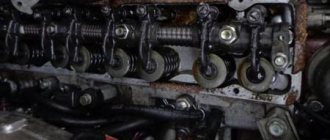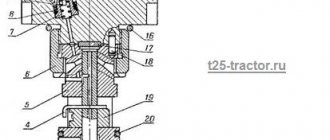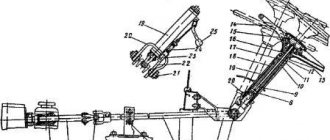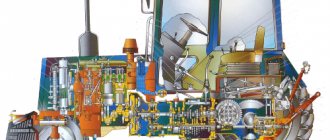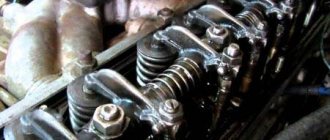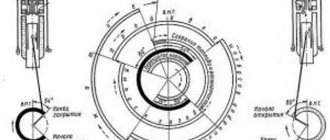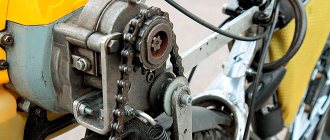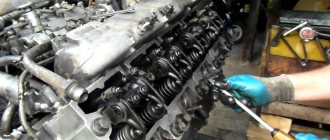You can adjust the YaMZ 236 valve yourself using the existing circuit. The procedure must be carried out regularly, since thermal gaps require constant adjustment. If the distance between the components does not meet the established standards, the distribution of gas inside the mechanism is disrupted. This is accompanied by accelerated wear of parts and increased load on valve seals. Increased gaps lead to engine overheating and a decrease in the tightness of the combustion chamber, which accelerates the erasure of the working chamfers of the elements. If you follow the instructions, you need to adjust the valves every 500 hours.
The operating order of YaMZ 236 cylinders without a turbine
The motor operates in the sequence: 1-4-2-5-3-6. This is significantly different from the internal combustion engine circuit. The work of adjusting the valves begins with the first cylinder. Its compression stroke is set.
The procedure ends with the 6th cylinder. The adjustment is based on equal clearances for the intake and exhaust elements. To get to them, the valve cover is removed.
Versatile and competitive
Probably the only enterprise in Russia that today can produce competitive diesel power units for trucks, as well as for construction equipment, is the Yaroslavl Motor Plant.
Any engine from the line represents brutality, reliability, ease of maintenance and simplicity. And more often than not, these motors show excellent capabilities for integration into the technology of the new century.
Cylinder layout
YaMZ 236 has the following valve arrangement.
The procedure is performed according to the same scheme: 1-4-2-5-3-6. The crankshaft is turned and adjustments are made in the same order.
After removing the valve cover, you first need to understand the location of the elements.
Helpful reminder:
- the exhaust valves are located opposite the exhaust manifold channels;
- inlet opposite to suction.
The adjustment is carried out when the engine is cold.
Engine Features
YaMZ 236 was developed in the 50s, and is still installed on more than 40 models of vehicles, including military ones, as well as tractors and Chinese heavy-duty tractors. Minor changes to its technical parameters affected mainly the turbocharging, power system, and gas exhaust. They made it possible to increase its power and efficiency, as well as reduce the level of exhaust gas pollution. YaMZ 236 has earned recognition from motorists thanks to:
- simplicity of design;
- rational placement of each component;
- high degree of unification of its components.
Gaps
Thermal gaps on all valves are 0.25-0.30 mm. After alignment, the crankshaft should be cranked. Now their size can change to 0.20-0.35 mm. The error lies within the tolerance range. It is not recommended to exceed the values for the following reasons: 1. With increased clearances, the valve lift height decreases. This significantly worsens the degree of filling of the cylinders with the combustible mixture. 2. The small size of the gaps does not provide a sufficient fit to the saddle.
The gaps are set only 1 hour after stopping the engine. Over time, it can reach a value of 0.4 mm. You will need to make another adjustment immediately.
Specifications
The engine has an impressive displacement of 11 liters. Power can vary from 150 to 420 horsepower, depending on the type and presence of turbocharging. In the latest modifications and versions, the parameter can be increased to 500 forces. Since the cost of fuel is constantly rising, the manufacturer has managed to reduce fuel consumption. So, if the Ural (car) previously consumed 40 liters per 100 kilometers, now the engine consumes only 25 liters. At the same time, the truck did not lose traction characteristics.
So, we found out the features of the power unit from the Yaroslavl Motor Plant.
Adjustment in one turn
Unlike other internal combustion engines, in the YaMZ 236 the top dead center of the piston is not fixed. To find it for the first cylinder, you need to focus on the moment of injection. When the crankshaft makes one revolution, there is a possibility of error. It is almost impossible to catch the top dead center of the piston using this method.
At a certain position of the crankshaft, the first valves are adjusted according to the existing scheme. After turning it one turn, the work is carried out with the rest. This setup requires highly qualified specialists.
Engine power system
The power supply system is equipped with a high and low pressure fuel pump with direct injection of the air-gas mixture. The pump is located between two rows of cylinders. The pump shaft rotates at a frequency two times lower than the crankshaft and provides a portion of fuel at precisely calculated moments.
YaMZ-236 engine power supply system
The block is cast from high-strength cast iron. To relieve thermal stress in the metal and maintain its precise configuration, it is treated with a special aging technique. To accommodate the connecting rod mechanism, the combustion chambers are shifted opposite each other by a certain distance.
The cylinder heads have two valves equipped with springs. Connecting to the valve with special locks, the spring plates ensure its rotation. Valve seats are made of cast iron alloys with high heat resistance. The valve cover is cast steel, with a sandwich gasket underneath.
The gas distribution mechanism uses special swinging pushers with rollers. The valves are driven by camshaft cams, rods and rocker arms. The material is:
- for the camshaft - carbon steel;
- pushers are steel, they are produced by stamping;
- intake valves – heat-resistant steel;
- graduations are welded, their plates are also made of hard alloys.
2 turn adjustment
The procedure begins with determining the TDC of the 1st cylinder. In this position, both valves are closed. The following actions are carried out:
- The crankshaft rotates clockwise relative to the engine end until the intake valve closes.
- Once done, turn the shaft an additional 1/3 turn. The graduation ceremony also closes here.
Next comes the adjustment. Procedure:
- The gap is checked using a feeler gauge between the rocker arm and the valve of cylinder 1. Its value should be in the range of 0.25-0.30 mm.
- If it is necessary to adjust the gap, use a wrench to unscrew the lock nut and rotate the screw to set the required distance.
- Then hold the screw with a screwdriver and at the same time tighten the locknut.
- To adjust the valves in the next cylinder, the shaft is rotated until its inlet closes. Then turn it another 1/3 turn.
- The procedure continues until all valves are adjusted.
Setting in 2 turns is a more reliable method, since the knee rotates to a strictly defined point.
How does the injection pump bypass valve work?
The injection pump bypass valve is located at the very beginning of the line, which sends remaining fuel to the tank. Its task is to discharge excess fuel.
The bypass valve consists of the following parts:
The operating principle of the valve is as follows.
When the power unit turns off, the pressure in the power system drops. In this case, the spring presses on the valve, which rises and closes the access hole into the drain pipe. When the engine starts, the pressure in the system rises. The fuel pressure presses the spring, and the valve opens the way for the remaining diesel fuel to drain into the return line. After the excess fuel is dumped, the pressure drops and the valve closes the line again.
Caring for the YaMZ 236 diesel power system
In order for the YaMZ 236 engine to work for a long time and uninterruptedly, and these power units, with proper care, can travel a million kilometers or more, it requires careful and careful care. Particular attention should be paid to the power system, as one of the most important systems of this power unit. The rules for caring for the YaMZ 236 power supply system are quite simple and easy to follow. First of all, you need to carefully monitor the quality of the fuel and always use diesel fuel that corresponds to the operating season. That is, in winter it is necessary to use winter diesel fuel, and in the regions of the far north - arctic. Another important element of caring for the YaMZ 236 diesel engine is timely cleaning and washing of the fuel filters and air cleaner. You also need not to be lazy, tighten all connections and fastenings of the power system as often as possible. If necessary, air must be removed from the system in a timely manner. You must remember to check the oil level in the fuel pump housing every day and if the level drops, top it up in a timely manner. Another important engine care procedure is daily cleaning of the fuel filters. This operation is performed as follows. At the end of the working day, immediately after stopping the engine, while it is still hot, 100-200 grams of dirty diesel fuel are drained from the preliminary and fine filters. After this, the engine starts at idle and the system is pumped. This way, the tightness of the power supply system is checked and, if necessary, loose connections are tightened. Another important stage in fuel system maintenance is seasonal maintenance. When changing seasons and when switching from one type of fuel to another, you need to remove the tank and wash it. At the same time, you must remember to purge all fuel lines. When carrying out maintenance-2 (TO-2), you need to disassemble the fuel filters and rinse them thoroughly. You also need to do the same procedure with the air purifier and fill it with oil. Actually, that's all. If you scrupulously follow these rules, your YaMZ 236 will serve you for a long time and without interruption. [
DETAIL_TEXT] => The YaMZ 236 engine was developed in the USSR back in the 50s at the Yaroslavl Motor Plant. This engine was most widely used in the Soviet Union. It could be found on heavy-duty MAZ and Ural vehicles, on K-700 and T-150 tractors, on various construction equipment, on boats and even on armored personnel carriers. Despite the fact that the motor will soon turn 60 years old, due to its outstanding characteristics and phenomenal reliability, it has not lost its relevance and today is still produced in Yaroslavl.
Diesel engines of trucks and tractors. Spare parts, adjustments and repairs.
Operations for adjusting the YaMZ-236 diesel engine
Adjusting the tension of the YaMZ-236 diesel belts The drive of the water pump, compressor and generator YaMZ-236 of the Ural, Maz, and T-150 tractors is carried out by V-belts, on the reliable operation of which the normal operation of these units depends.
Therefore, during daily maintenance of engines, protect the belts from oil and fuel, monitor their tension and adjust it.
Check the belt tension especially carefully during the first 50 hours of engine operation, since at this time they are most stretched.
Belt tension should always be normal, since both excessive and insufficient tension leads to premature failure.
In addition, excessive tension on the drive belt of the YaMZ-236 water pump can cause destruction of the pump bearings.
Afterword
When operating a MAZ vehicle, it is not uncommon to have to seriously strain yourself; many of us are faced with sciatica and similar diseases. Therefore, when you lift some parts, remember your health. In my youth, I went to lift weights, I didn’t achieve great results, but I remembered the words of the coach. He said that if you want to be friends with the barbell, then train your legs. After all, the average person’s dead abs pull about 200 kg, so load your legs while keeping your back straight.
YaMZ-238 engine block head
For reference, the YaMZ-238 engine head weighs about 90 kg, and the crankshaft 120 kg. Parts of domestic engines are not easy.
However, I had to remove the head from the YaMZ-238 engine many times alone: either you tear it off the gasket with a pry bar, or with the help of your legs, with a straight back and outstretched arms, you manage to lift it from the studs and move it onto the wheel.
I hope that such exercises were given to me without harm to my health. However, it is undoubtedly better to drag such parts together or using lifting mechanisms.
Setting the advance angle
The required advance value is located next to the special mark. The YaMZ 236 fuel injection advance clutch is where this risk is applied. The normal value is 20 or 18 points. The angle of the fuel mass itself is determined by the primary cylinder.
Control is carried out using a conventional pump. So, they work on the power supply system of a car engine, without fail, first opening the valves through which air escapes from the engine. After the air masses have come out without any residue, the plugs are wrapped. Next, you should connect the momentoscope device to the fittings of the special section from the fuel pump. Before carrying out the procedure, it is necessary to remove the injection pump of the Yamz 236 cylinder.
The advance is adjusted as follows:
- the bracket from the working power apparatus is transferred to the working state;
- drain all the fuel from the glass container until the volume of liquid reaches the mark in the middle part of the tube;
- carefully turn the crankshaft.
All movements must be made strictly in the direction of torsion. The current position of the meniscus in the tube must be constantly observed and monitored. Its sharp rise signals the start of fuel start-up by a certain section. The line marked on the pulley should be opposite the line with the number marks. The procedure for setting the angle requires special accuracy up to 1 value.
Modifications [edit | edit code]
YaMZ-236 [edit | edit code]
- Number of cylinders: 6;
- Number of valves: 12;
- Working volume: 11,150 cm3.
- 150 hp (110 kW) at 1700 rpm - YaMZ-236G
- 165 hp (121 kW) at 1800 rpm, 736 N•m (75 kgf•m) at 1300 rpm - YaMZ-236NB
- 175 hp (129 kW) at 2100 rpm, 667 N•m (68 kgf•m) at 1400 rpm - YaMZ-236DK
- 180 hp (132 kW) at 2100 rpm, 667 N•m (68 kgf•m) at 1500 rpm - YaMZ-236
(basic) - 185 hp (136 kW) at 1900 rpm, 833 N•m (90 kgf•m) at 1300 rpm - YaMZ-236NK
- 210 hp (154 kW) at 1900 rpm, 882 N•m (90 kgf•m) at 1300 rpm - YaMZ-236ND
- 230 hp (169 kW) at 2100 rpm, 882 N•m (90 kgf•m) at 1300 rpm - YaMZ-236NE
- 230 hp (169 kW) at 1900 rpm, 882 N•m (90 kgf•m) at 1200 rpm - YaMZ-6563
- 230 hp (169 kW) at 2100 rpm, 882 N•m (90 kgf•m) at 1300 rpm - YaMZ-236N
- 230 hp (169 kW) at 2100 rpm, 882 N•m (90 kgf•m) at 1200 rpm - YaMZ-236NE2
- 250 hp (184 kW) at 2000 rpm, 1030 N•m (105 kgf•m) at 1200 rpm - YaMZ-236BK
- 250 hp (184 kW) at 1900 rpm, 1128 N•m (115 kgf•m) at 1200 rpm - YaMZ-6562
- 250 hp (184 kW) at 2000 rpm, 1030 N•m (105 kgf•m) at 1300 rpm - YaMZ-236B
- 250 hp (184 kW) at 2000 rpm, 1078 N•m (110 kgf•m) at 1200 rpm - YaMZ-236BE2
- 300 hp (220 kW) at 1900 rpm, 1275 N•m (130 kgf•m) at 1200 rpm - YaMZ-7601
- 180 hp (132 kW) at 2100 rpm, 667 N•m (68 kgf•m) at 1200 rpm - YaMZ-236M2
Base engine performance: 180 hp. (132 kW) at 2100 rpm, 667 N•m (68 kgf•m) at 1500 rpm
YaMZ-238 [edit | edit code ]
- Number of cylinders: 8;
- Number of valves: 16;
- Displacement: 14,866 cm3
- 235 hp (173 kW) at 1700 rpm, 1108 N•m (113 kgf•m) at 1300 rpm - YaMZ-238ND3
- 235 hp (173 kW) at 1700 rpm, 1108 N•m (113 kgf•m) at 1300 rpm - YaMZ-238ND6
- 240 hp (176 kW) at 2100 rpm, 883 N*m (90 kgf*m) at 1350 rpm - YaMZ-238M2
- 240 hp (177 kW) at 2100 rpm, 889 N*m (90 kgf*m) at 1500 rpm - YaMZ-238
(basic) - 250 hp (184 kW) at 1900 rpm, 1108 N•m (113 kgf•m) at 1300 rpm - YaMZ-238ND4
- 250 hp (184 kW) at 1900 rpm, 1108 N•m (113 kgf•m) at 1300 rpm - YaMZ-238ND7
- 280 hp (206 kW) at 2100 rpm, 1029 N•m (105 kgf•m) at 1500 rpm - YaMZ-238PM
- 290 hp (184 kW) at 2000 rpm, 1128 N•m (115 kgf•m) at 1400 rpm - YaMZ-238DK
- 300 hp (220 kW) at 1900 rpm, 1280 N•m (131 kgf•m) at 1300 rpm - YaMZ-238ND5
- 300 hp (220 kW) at 1900 rpm, 1280 N•m (131 kgf•m) at 1300 rpm - YaMZ-238ND8
- 320 hp (235 kW) at 2100 rpm, 1117 N•m (114 kgf•m) at 1500 rpm - YaMZ-238FM
- 330 hp (243 kW) at 2000 rpm, 1225 N•m (125 kgf•m) at 1400 rpm - YaMZ-238DK
- 330 hp (243 kW) at 2100 rpm, 1225 N•m (125 kgf•m) at 1300 rpm - YaMZ-238D
- 330 hp (243 kW) at 2100 rpm, 1225 N•m (125 kgf•m) at 1300 rpm - YaMZ-238DE
- 330 hp (243 kW) at 2100 rpm, 1274 N•m (130 kgf•m) at 1200 rpm - YaMZ-238DE2
- 330 hp (243 kW) at 1900 rpm, 1274 N•m (130 kgf•m) at 1200 rpm - YaMZ-6582
- 360 hp (265 kW) at 1900 rpm, 1570 N•m (160 kgf•m) at 1200 rpm - YaMZ-7512
- 400 hp (294 kW) at 1900 rpm, 1715 N•m (175 kgf•m) at 1200 rpm - YaMZ-7511
- 400 hp (294 kW) at 1900 rpm, 1764 N•m (180 kgf•m) at 1200 rpm - YaMZ-6581
- 420 hp (309 kW) at 1900 rpm, 1764 N•m (180 kgf•m) at 1200 rpm - YaMZ-7513
Expert advice
It is best to make a torque scope yourself so that the device fits perfectly to the engine. You can create a device from several tubes. During operation, it is necessary to monitor the tightness of the tubes and prevent leaks.
Another important point is the process of pumping diesel fuel until the tube appears in sight. Inflating is done by rotating the shaft. A rise in the fuel mass will be noticeable when the shaft is rotated before directly approaching the elements of the first piston. It is important to rotate the shaft smoothly and very slowly.

